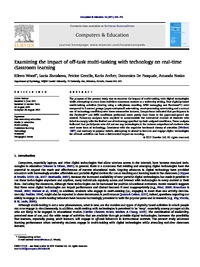 Diese Seite wurde seit 2 Jahren inhaltlich nicht mehr aktualisiert.
Unter Umständen ist sie nicht mehr aktuell.
Diese Seite wurde seit 2 Jahren inhaltlich nicht mehr aktualisiert.
Unter Umständen ist sie nicht mehr aktuell.
 Zusammenfassungen
Zusammenfassungen
The purpose of the present study was to examine the impact of multi-tasking with digital technologies
while attempting to learn from real-time classroom lectures in a university setting. Four digitally-based
multi-tasking activities (texting using a cell-phone, emailing, MSN messaging and Facebook were
compared to 3 control groups (paper-and-pencil note-taking, word-processing note-taking and a natural
use of technology condition) over three consecutive lectures. Comparisons indicated that participants in
the Facebook and MSN conditions performed more poorly than those in the paper-and-pencil use
control. Follow-up analyses were required to accommodate the substantial number of students who
failed to comply with the limited use of technology specified by their assigned conditions. These analyses
indicated that participants who did not use any technologies in the lectures outperformed students who
used some form of technology. Consistent with the cognitive bottleneck theory of attention (Welford,
1967) and contrary to popular beliefs, attempting to attend to lectures and engage digital technologies
for off-task activities can have a detrimental impact on learning.
Von Eileen Wood, Lucia Zivcakova, Petrice Gentile, Karin Archer, Domenica De Pasquale, Amanda Nosko im Text Examining the impact of off-task multi-tasking with technology on real-time classroom learning (2011)  Dieser Text erwähnt ...
Dieser Text erwähnt ...
 Personen KB IB clear | Deborah L. Lowther , Gary R. Morrison , Marc Prensky , Steven M. Ross | |||||||||||||||||||||||||||
 Aussagen KB IB clear | Multitasking macht ineffizient | |||||||||||||||||||||||||||
 Begriffe KB IB clear |  Aufmerksamkeit / Fokus Aufmerksamkeit / Fokus attention
, cognitive load theory (CLT)
, attention
, cognitive load theory (CLT)
,  E-Mail E-Mail e-mail
, e-mail
,  facebook
, facebook
,  Lernen Lernen learning
, learning
,  Multitasking Multitasking Multitasking Multitasking
| |||||||||||||||||||||||||||
 Bücher |
| |||||||||||||||||||||||||||
 Texte |
|
 Zitationsgraph
Zitationsgraph
 Zitationsgraph (Beta-Test mit vis.js)
Zitationsgraph (Beta-Test mit vis.js)
 3 Erwähnungen
3 Erwähnungen 
- No A 4 U - The relationship between multitasking and academic performance (Reynol Junco, Shelia R. Cotten) (2012)


- Cyberkrank! - Wie das digitalisierte Leben unsere Gesundheit ruiniert (Manfred Spitzer) (2015)

- Is the Pencil Mightier than the Keyboard? - A Meta-Analysis Comparing the Method of Notetaking Outcomes (Mike Allen, Luke LeFebvre, Leah E. LeFebvre, John Bourhis) (2020)


 Anderswo finden
Anderswo finden
 Volltext dieses Dokuments
Volltext dieses Dokuments
 |  Examining the impact of off-task multi-tasking with technology on real-time classroom learning: Artikel als Volltext ( Examining the impact of off-task multi-tasking with technology on real-time classroom learning: Artikel als Volltext ( : :  , 179 kByte; , 179 kByte;  : :  2021-03-21) 2021-03-21) |
 Anderswo suchen
Anderswo suchen 
 Beat und dieser Text
Beat und dieser Text
Beat hat Dieser Text während seiner Zeit am Institut für Medien und Schule (IMS) ins Biblionetz aufgenommen. Beat besitzt kein physisches, aber ein digitales Exemplar. Eine digitale Version ist auf dem Internet verfügbar (s.o.). Es gibt bisher nur wenige Objekte im Biblionetz, die dieses Werk zitieren.












 Biblionetz-History
Biblionetz-History